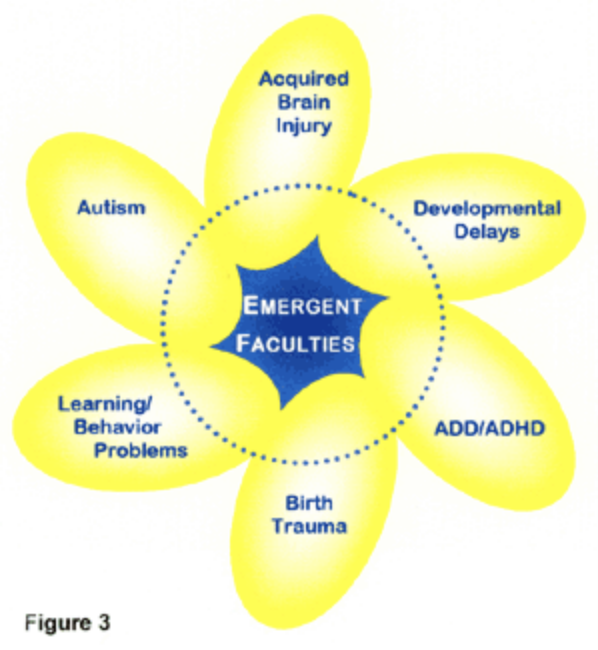The conscious and intellectual aspects of learning are inhibited, when problems are present that impair a person’s Emergent Faculties. In a child with developmental delays, these faculties may be only partially developed. In other individuals, these faculties may become impaired as a result of brain injury. Whether the faculties are impaired or only partially developed, the outcome is the same. Common activities that depend upon well-organized brainstem functioning (for example: learning to ride a bike, throw a ball, read or interact with others) can seem unreasonably difficult.
There are three general states of Emergent Faculties:
Normal – The existence of reasonably well developed neurosensory reception, processing and integration faculties. The person who is able to relate to the people, places and things around them and interact socially in a customary or accepted manner demonstrates normal faculties.
Potential – The existence of inherent ability or capacity for growth or development of neurosensory reception, processing and integration faculties. This state may be present in any individual who has experienced a situation or condition that interferes with the normal development of these faculties in the womb or during infancy or childhood.
Impaired – A diminished ability in the area of neurosensory reception, processing and integration faculties. This state is present in the individual that previously possessed normal Emergent Faculties, but has experienced impairment of them as the result of an event such as acquired brain injury. In the case of a person with potential or impaired Emergent Faculties, a variety of problems can be observed. In the area of sensory reception, problems may include hyper/hyposensitivity to light or sound, ear dominance issues, visual field constriction and gravitational insecurity (unreasonable anxiety when on anything moving, etc.). For sensory processing and integration, the problems associated with potential or impaired Emergent Faculties can manifest as sensory integration dysfunction, inefficient and irregular learning ability, inaccurate sensory perception, coordination difficulties, hypervigilance to incoming sensory messages, inappropriate social behaviors, slow mental processing or impaired memory. The Sensory Learning Program is an educational approach to developmental learning that provides remediation of potential or impaired Emergent Faculties in individuals regardless of their diagnosis or condition. It is important to note here that the Sensory Learning Program does not treat or cure conditions such as those shown in Figure 3. Rather, it is an innovative approach to sensory developmental education.
Brains are more alike than they are different. Everyone has Emergent Faculties, and they are the common denominator among diverse populations such as those shown in Figure 3. It is this common element that enables the Sensory Learning Program to be highly effective even across diverse populations. When the brainstem area becomes better organized, higher cortical activities such as math, reading, written and oral expressive language, receptive language and general spatial/temporal orientation are more easily learned and refined. They depend on a good foundation of neurosensory faculties in the brainstem area. The Sensory Learning Program simultaneously re-educates the individual’s primary sensory functions and retrains their Emergent Faculties. When these faculties are integrated, sensory functioning is effortless and integrated, the individual is highly adaptive, body movements are well coordinated, learning is easy and appropriate behavioral responses are natural outcomes.



